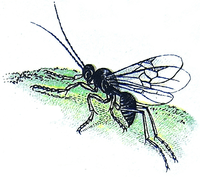Cotesia glomerata
| Cotesia glomerata | |
|---|---|
 | |
| A Cotesia glomerata drawing | |
| Scientific classification | |
| Kingdom: | Animalia |
| Phylum: | Arthropoda |
| Class: | Insecta |
| Order: | Hymenoptera |
| Family: | Braconidae |
| Genus: | Cotesia |
| Species: | C. glomerata |
| Binomial name | |
| Cotesia glomerata (Linnaeus, 1758) | |
| Synonyms | |
| |
Cotesia glomerata, the White Butterfly Parasite, is small parasitic wasp species belonging to family Braconidae.
Description

The adults of Cotesia glomerata can reach a length of 3–7 millimetres (0.12–0.28 in). This small braconid wasp is black, with two pairs of wings. It can parasitize a wide range of Pieris butterfly species as host, but Pieris brassicae and Pieris rapae are the main hosts. The adults feed on nectar.[2]
Life cycle
After hatching from the pupae, the females mate and start laying eggs. They eggs are laid in larvae of caterpillars, where the C. glomerata larvae develop. After 15 to 20 days the larvae emerge and the caterpillar dies. The larvae are placed in a heap of yellow silken cocoons attached to the host plant. After 15–20 days the larvae spin their cocoons from which a new generation emerges.[3]
C. glomerata is itself in turn parasitized by the hyperparasite wasp Lysibia nana.
Distribution
This species is present in most of Europe, in the Afrotropic ecozone, in the Australasian ecozone, in the Nearctic ecozone and in the Neotropical ecozone.[4]
References
- ↑ Biolib
- ↑ Laing, J.E.; Levin, D.B. (1982). "A review of the biology and a bibliography of Apanteles glomeratus (L.) (Hymenoptera: Braconidae)". Biocontrol News and Information 3 (1): 7–23. ISSN 0143-1404.
- ↑ A. Shelton A Guide to Natural Enemies in North America
- ↑ Fauna Europaea
Further reading
- Karowe, D. N.; Schoonhoven, L. M. (1992). "Interactions among three trophic levels: The influence of host plant on performance of Pieris brassicae and its parasitoid, Cotesia glomerata". Entomologia Experimentalis et Applicata 62 (3): 241–51. doi:10.1111/j.1570-7458.1992.tb00664.x.
- Mattiacci, Letizia; Dicke, Marcel (1995). "Host-age discrimination during host location by Cotesia glomerata, a larval parasitoid of Pieris brassicae". Entomologia Experimentalis et Applicata 76: 37–48. doi:10.1111/j.1570-7458.1995.tb01944.x.
- Wäckers, F.L. (2001). "A comparison of nectar- and honeydew sugars with respect to their utilization by the hymenopteran parasitoid Cotesia glomerata". Journal of Insect Physiology 47 (9): 1077–1084. doi:10.1016/S0022-1910(01)00088-9. PMID 11472770.
- Coleman, R. A.; Barker, A. M.; Fenner, M. (1999). "Parasitism of the herbivore Pieris brassicae L. (Lep., Pieridae) by Cotesia glomerata L. (Hym., Braconidae) does not benefit the host plant by reduction of herbivory". Journal of Applied Entomology 123 (3): 171–7. doi:10.1046/j.1439-0418.1999.00334.x.
- Gu, Hainan; Wang, Qun; Dorn, Silvia (2003). "Superparasitism in Cotesia glomerata: Response of hosts and consequences for parasitoids". Ecological Entomology 28 (4): 422–31. doi:10.1046/j.1365-2311.2003.00535.x.
External links
- "Wasps Emerge From Caterpillar". Parasitic Wasps: Alien on Earth. In the Womb: Extreme Animals. National Geographic. May 16, 2009.
- Entomology